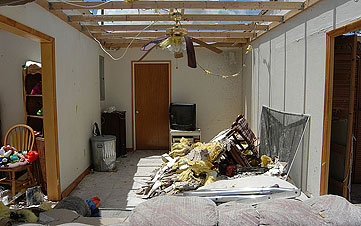10 Costliest Catastrophes in the U.S.
Catastrophes destroy homes and vehicles, displace families and interrupt business.

Catastrophes destroy homes and vehicles, displace families and interrupt business. The question is, who pays?
With the 2012 hurricane season in full swing, residents of the East and Gulf coasts are reminded yet again that disaster can strike with little warning. Having the right insurance is important. If an event similar to the Great Miami Hurricane of 1926 were to strike today, it would result in insured losses of $125 billion, estimates Karen Clark & Co., a risk-management firm, due to the greater concentration of people and property in coastal areas. Back then, however, few carried insurance.
But Americans seem to have learned their lesson. Our ranking of the ten costliest catastrophes to hit the U.S. based on insured losses is dominated entirely by events of the past two decades. Even a relatively recent catastrophe, such as 1992’s Hurricane Andrew, would be three times as costly today.
With each event, you'll find our guidance on how to best protect yourself against similar losses. Data on initial insured losses was provided by ISO's Property Claims Services unit, which helps assess risk for the insurance industry. The U.S. Bureau of Labor Statistics' CPI Inflation Calculator was used to determine losses in 2012 dollars.

1. Hurricane Katrina
Year: 2005
Areas affected: Alabama, Florida, Georgia, Louisiana, Mississippi, Tennessee
Insured losses (then): $41.1 billion
Insured losses (in 2012 dollars): $48.2 billion
Disaster insurance tip: Most homeowners insurance policies exclude floods. Check yours. The National Flood Insurance Program offers supplemental flood coverage to anyone in the U.S. The average flood premium is about $600 a year. Basic policies for low- to moderate-risk areas start at $129.

2. Hurricane Andrew
Year: 1992
Areas affected: Florida, Louisiana
Insured losses (then): $15.5 billion
Insured losses (in 2012 dollars): $25.3 billion
Disaster insurance tip: Mold is a four-letter word in the insurance business. If water enters your home, be it due to wind-driven rain, rising floodwaters or even a leaky pipe, work quickly to dry out wet spots and prevent future infiltration. Moisture is the key to mold growth. Also think twice before submitting a small water-related claim. Some insurers might raise premiums or even cancel coverage for fear the minor water damage will turn into a major mold cleanup.

3. 9/11 Terrorist Attacks
Year: 2001
Areas affected: New York, Pennsylvania, Virginia
Insured losses (then): $18.8 billion
Insured losses (in 2012 dollars): $24.3 billion
Disaster insurance tip: Homeowners and renters should be covered by standard policies in the event of a terrorist attack. In general, if your policy covers the type of damage you experience, such as fire, then you’ll get reimbursed even if the damage results from terrorism. Keep in mind, however, that homeowners insurance and renters insurance typically exclude acts of war and nuclear disasters. Read the fine print.

4. Northridge (Calif.) Earthquake
Year: 1994
Areas affected: California
Insured losses (then): $12.5 billion
Insured losses (in 2012 dollars): $19.3 billion
Disaster insurance tip: California doesn’t have a monopoly on earthquakes. A big quake centered in Virginia shook the East Coast in 2011. Damage to your car should be covered by your auto policy, but standard homeowners insurance excludes earthquakes. To insure your home, you’ll need to add an endorsement to your policy or purchase separate earthquake insurance.

5. Hurricane Ike
Year: 2008
Areas affected: Arkansas, Illinois, Indiana, Kentucky, Louisiana, Missouri, Ohio, Pennsylvania, Texas
Insured losses (then): $12.5 billion
Insured losses (in 2012 dollars): $13.3 billion
Disaster insurance tip: Filing an insurance claim after a disaster is hard enough, but it’s especially tough if you don’t have detailed records of your belongings. That’s where a home inventory comes in. Use a digital camera or camcorder to document your possessions. Online inventory programs are also available. Or simple pen and paper can do the job. No matter the method, keep a copy of your home inventory in a safe place.

6. Hurricane Wilma
Year: 2005
Areas affected: Florida
Insured losses (then): $10.3 billion
Insured losses (in 2012 dollars): $12.1 billion
Disaster insurance tip: The IRS allows taxpayers who itemize to deduct casualty losses related to disasters such as floods, earthquakes, hurricanes, tornadoes and even volcanic eruptions. The calculations can get tricky. In general, to figure your deduction you’ll need to subtract any insurance reimbursements from your loss, then subtract $100 for each casualty that occurs during the year, and then subtract 10% of your adjustable gross income. Any leftover amount is your deductible casualty loss. Special tax rules apply to losses incurred in federally declared disaster areas.

7. Hurricane Charley
Year: 2004
Areas affected: Florida, North Carolina, South Carolina
Insured losses (then): $7.5 billion
Insured losses (in 2012 dollars): $9.1 billion
Disaster insurance tip: Keep important documents secure from the ravages of disaster. It’s usually best to stash wills, deeds, birth certificates, marriage licenses and the like away from home, such as in a bank safe-deposit box. If you prefer to have originals close at hand, invest in a fireproof and waterproof safe. Online backup services, such as Mozy.com and Carbonite.com, allow you, for a fee, to preserve your electronic files in the event computers and other devices are destroyed.

8. Hurricane Ivan
Year: 2004
Areas affected: Alabama, Delaware, Florida, Georgia, Louisiana, Maryland, Mississippi, New Jersey, New York, North Carolina, Ohio, Pennsylvania, Tennessee, Virginia, West Virginia
Insured losses (then): $7.1 billion
Insured losses (in 2012 dollars): $8.6 billion
Disaster insurance tip: Preparation is the key to weathering any calamity. Long before disaster strikes, review your home, auto and life insurance to ensure that policies are up to date. Keep a list of important phone numbers handy, including the direct line to your insurance agent. Devise an evacuation plan for your family, and put together an emergency kit. Useful items include a portable radio, a rechargeable lantern and perhaps even a wad of cash in case you can’t get to a bank.

9. Hurricane Hugo
Year: 1989
Areas affected: Georgia, North Carolina, Puerto Rico, South Carolina, Virginia, U.S. Virgin Islands
Insured losses (then): $4.2 billion
Insured losses (in 2012 dollars): $7.8 billion
Disaster insurance tip: Don’t delay until the last minute to look into disaster insurance. There are often mandatory waiting periods before a policy kicks in. With flood insurance, for example, the wait is usually 30 days. Foot-dragging can prove costly. Just an inch of floodwater can cause about $21,000 in damage to a typical home.

10. Hurricane Rita
Year: 2005
Areas affected: Alabama, Arkansas, Louisiana, Mississippi, Tennessee and Texas
Insured losses (then): $5.6 billion
Insured losses (in 2012 dollars): $6.6 billion
Disaster insurance tip: Having the right insurance coverage in place is indispensible in the event of a disaster, but you shouldn’t pay a penny more in premiums than necessary. There are three easy ways to save on home and auto insurance. First, shop around. Different carriers offer different rates. Second, ask about multi-policy discounts, claims-free discounts and others. Third, raise your deductible to the highest amount you can afford.

Profit and prosper with the best of Kiplinger's advice on investing, taxes, retirement, personal finance and much more. Delivered daily. Enter your email in the box and click Sign Me Up.

-
 Forget Financial Forecasts: Focus on These 3 Goals for Success
Forget Financial Forecasts: Focus on These 3 Goals for SuccessWe know the economy is unpredictable and markets will do what they do, no matter who predicts what. Here's how to focus on what you can control.
-
 Why In-Person Financial Guidance Remains the Gold Standard
Why In-Person Financial Guidance Remains the Gold StandardFace-to-face conversations between advisers and clients provide the human touch that encourages accountability and a real connection.
-
 How You Can Turn Your Home Equity Into a Retirement Buffer
How You Can Turn Your Home Equity Into a Retirement BufferIf you're one of the many homeowners who has the bulk of your net worth tied up in your home equity, you might consider using that equity as a planning tool.
-
 What to Do With Your Tax Refund: 6 Ways to Bring Growth
What to Do With Your Tax Refund: 6 Ways to Bring GrowthUse your 2024 tax refund to boost short-term or long-term financial goals by putting it in one of these six places.
-
 What Does Medicare Not Cover? Eight Things You Should Know
What Does Medicare Not Cover? Eight Things You Should KnowMedicare Part A and Part B leave gaps in your healthcare coverage. But Medicare Advantage has problems, too.
-
 15 Reasons You'll Regret an RV in Retirement
15 Reasons You'll Regret an RV in RetirementMaking Your Money Last Here's why you might regret an RV in retirement. RV-savvy retirees talk about the downsides of spending retirement in a motorhome, travel trailer, fifth wheel, or other recreational vehicle.
-
 The Six Best Places to Retire in New England
The Six Best Places to Retire in New Englandplaces to live Thinking about a move to New England for retirement? Here are the best places to land for quality of life, affordability and other criteria.
-
 The 10 Cheapest Countries to Visit
The 10 Cheapest Countries to VisitWe find the 10 cheapest countries to visit around the world. Forget inflation and set your sights on your next vacation.
-
 15 Ways to Prepare Your Home for Winter
15 Ways to Prepare Your Home for Winterhome There are many ways to prepare your home for winter, which will help keep you safe and warm and save on housing and utility costs.
-
 Six Steps to Get Lower Car Insurance Rates
Six Steps to Get Lower Car Insurance Ratesinsurance Shopping around for auto insurance may not be your idea of fun, but comparing prices for a new policy every few years — or even more often — can pay off big.
-
 How to Increase Credit Scores — Fast
How to Increase Credit Scores — FastHow to increase credit scores quickly, starting with paying down your credit card debt.
